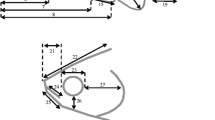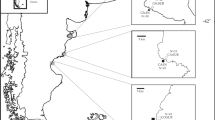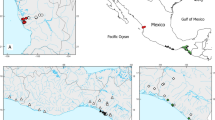Abstract
We tested if variations (i.e., breadth) in morphology and habitat use vary predictably among six aquatic gastropod species that were collected across Indiana and Illinois, USA. We predicted that interspecific morphological variation would positively covary with variation in habitat use among species. We used geometric morphometrics (Procrustes technique and relative warp analysis) to quantify morphology and multivariate analyses (PCA) to quantify habitat. Increased morphological breadth did not vary predictably with increased habitat breadth. However, we found that life history traits correspond with patterns in morphological and habitat breadth for these six aquatic gastropods. Pulmonate gastropods (use lungs for respiration) that lack an operculum cover exhibited decreased morphological breadth compared to coenogastropods (use gills for respiration). This pattern may ultimately be a function of behavioral adaptations in freshwater gastropods. Gastropods that are capable of breathing air or using other behavioral modifications such as burrowing to escape predators may not require high morphological breadth. Conversely, selection may favor higher morphological breadth in gastropods with gills that also do not move out of the water column to escape predators.







Similar content being viewed by others
References
Bolnick, D. I., R. Svänback, J. A. Bordyce, L. H. Yang, J. M. Davis, C. D. Hulsey & M. L. Forister, 2003. The ecology of individuals: incidence and implications of individual specialization. American Naturalist 161: 1–28.
Bolnick, D. I., R. Svänback, M. S. Araújo & L. Persson, 2007. Comparative support for the niche variation hypothesis that more generalized populations also are more heterogeneous. Proceedings of the National Academy of Sciences USA 104: 10075–10079.
Bookstein, F., 1991. Morphometric Tools for Landmark Data: Geometry and Biology. Cambridge University Press, Cambridge.
Brönmark, C., T. Lakowitz & J. Hollander, 2011. Predator-induced morphological plasticity across local populations of a freshwater snail. PLoS One 6: e21773.
Cochran-Biederman, J. L. & K. O. Winemiller, 2010. Relationships among habitat, ecomorphology and diets of cichlids in the Bladen River, Belize. Environmental Biology of Fishes 88: 143–152.
Cornwell, W. K., D. W. Schwilk & D. D. Ackerly, 2006. A trait-based test for habitat filtering: convex hull volume. Ecology 87: 1465–1471.
Covich, A. P., 2010. Winning the biodiversity arms race among freshwater gastropods: competition and coexistence through shell variability and predator avoidance. Hydrobiologia 653: 191–215.
Crowl, T. A. & A. P. Covich, 1990. Predator-induced life-history shifts in a freshwater snail. Science 247: 949–951.
DeWitt, T. J., A. Sih & D. S. Wilson, 1998. Costs and limits of phenotypic plasticity. Trends Ecology and Evolution 13: 77–81.
DeWitt, T. J., B. W. Robinson & D. S. Wilson, 2000. Functional diversity among predators of a freshwater snail imposes an adaptive trade-off for shell morphology. Evolutionary Ecology Research 2: 129–148.
Dillon, R. T., 2011. Robust shell phenotype is a local response to stream size in the genus Pleurocera (Rafinesque, 1818). Malacologia 53: 265–277.
Dillon, R. T., S. J. Jacquemin & M. Pyron, 2013. Cryptic phenotypic plasticity in populations of the freshwater prosobranch snail, Pleurocera canaliculata. Hydrobiologia 709: 117–127.
Dunithan, A., S. Jacquemin & M. Pyron, 2012. Morphology of Elimia livescens (Mollusca: Pleuroceridae) in Indiana, USA. American Malacological Bulletin 30: 127–133.
Felsenstein, J., 1985. Phylogenies and the comparative method. American Naturalist 125: 1–15.
Healy, R. W., 1979. River Mileages and Drainage Areas for Illinois Streams. Department of the Interior, US Geological Survey and US Army Corps of Engineers – Report 79–110.
Hoggatt, R. E., 1975. Drainage Area of Indiana Streams. Department of the Interior, US Geological Survey, Indianapolis.
Holomuzki, J. R. & B. J. F. Biggs, 2006. Habitat-specific variation and performance trade-offs in shell armature of New Zealand mudsnails. Ecology 87: 1038–1047.
Hoverman, J. T., J. R. Auld & R. A. Relyea, 2005. Putting prey back together again: integrating predator-induced behavior, morphology, and life history. Oecologia 144: 481–491.
Hutchinson, G. E., 1959. Homage to Santa Rosalia, or why are there so many kinds of animals? American Naturalist 93: 145–159.
Jackson, D. A., 1993. Stopping rules in principal components analysis: a comparison of heuristical and statistical approaches. Ecology 74: 2204–2214.
Jacquemin, S. J. & M. Pyron, 2011. Fishes of Indiana streams: current and historic assemblage structure. Hydrobiologia 665: 39–50.
Julliard, R., J. Clavel, V. Devictor, F. Jiguet & D. Couvet, 2006. Spatial segregation of specialists and generalists in bird communities. Ecology Letters 9: 1237–1244.
Kemp, P. & M. D. Bertness, 1984. Snail shape and growth rates: evidence for plastic shell allometry in Littorina littorea. Proceedings of the Academy of Sciences USA 81: 811–813.
Klingenberg, C. P. & G. S. McIntyre, 1998. Geometric morphometrics of developmental instability: analyzing patterns of fluctuating asymmetry with procrustes methods. Evolution 52: 1363–1375.
Knouft, J. H., N. M. Caruso, P. J. Dupre, D. R. Anderson, D. R. Trumbo & J. Puccinelli, 2011. Using fine-scale GIS data to assess the relationship between intra-annual environmental niche variability and population density in a local stream fish assemblage. Methods in Ecology and Evolution 2: 303–311.
Lodge, D. M., K. M. Brown, S. P. Klosiewski, R. A. Stein, A. P. Covich, B. K. Leathers & C. Brönmark, 1987. Distribution of freshwater snails: spatial scale and the relative importance of physicochemical and biotic factors. American Malacological Bulletin 5: 73–84.
Maddison, W. P. & D. R. Maddison. 2011. Mesquite: a modular system for evolutionary analysis. Version 2.75, http://mesquiteproject.org. Accessed Dec 2011.
McClain, C. R., N. A. Johnson & M. A. Rex, 2004. Morphological disparity as a biodiversity metric in lower bathyal and abyssal gastropod assemblages. Evolution 58: 338–348.
Minton, R. L., A. P. Norwood & D. M. Hayes, 2008. Quantifying phenotypic gradients in freshwater snails: a case study in Lithasia (Gastropoda: Pleuroceridae). Hydrobiologia 605: 173–182.
Mower, C. M. & A. M. Turner, 2004. Behavior, morphology, and the coexistence of two pulmonate snails with molluscivorous fish: a comparative approach. American Malacological Bulletin 19: 39–46.
Palmer, A. R., 1992. Calcification in marine molluscs: how costly is it? Proceedings of the National Academy of Science USA 89: 1379–1382.
Price, S. A., P. C. Wainwright, D. R. Bellwood, E. Kazancioglu, D. C. Collar & T. J. Near, 2010. Functional innovations and morphological diversification in parrotfish. Evolution 64: 3057–3068.
Pyron, M., J. Beugly, E. Martin & M. Spielman, 2008. Conservation of the freshwater gastropods of Indiana: historic and current distributions. American Malacological Bulletin 26: 137–151.
Pyron, M., J. Beugly, M. Spielman, J. Pritchett & S. Jacquemin, 2009. Habitat variation among aquatic gastropod assemblages of Indiana, USA. The Open Zoology Journal 2: 8–14.
Relyea, R. A., 2002. Costs of phenotypic plasticity. American Naturalist 3: 272–282.
Remigio, E. A. & P. D. N. Hebert, 2003. Testing the utility of partial COI sequences for phylogenetic estimates of gastropod relationships. Molecular Phylogenetics and Evolution 29: 641–647.
Ricklefs, R. E. & D. B. Miles, 1994. Ecological and evolutionary inferences from morphology: an ecological perspective. In Wainwright, P. C. & S. M. Reilly (eds), Ecological Morphology: Integrative Organismal Biology. University of Chicago Press, Chicago: 13–41.
Rohlf, F. L., 1990. Rotational fit (Procrustes) methods. In Rohlf, P. C. & F. Bookstein (eds), Proceedings of the Michigan morphometrics workshop. University of Michigan Museum of Zoology, Ann Arbor, MI: 13–41.
Rohlf, F. L., 2007. tpsRelw Version 1.45. SUNY, Stony Brook, NY.
Rohlf, F. L., 2008. tpsDig Version 2.11. SUNY, Stony Brook, NY.
Rundle, S. D. & C. Brönmark, 2001. Inter- and intraspecific trait compensation of defence mechanisms in freshwater snails. Proceedings of the Royal Society London B 268: 1463–1468.
Schilithuizen, M. & M. Haase, 2010. Disentangling true shape differences and experimenter bias: are dextral and sinistral snail shells exact mirror image? Journal of Zoology 282: 191–200.
Turner, A. M. & S. L. Montgomery, 2009. Hydroperiod, predators and the distribution of physid snails across the freshwater habitat gradient. Freshwater Biology 54: 1189–1201.
Van Valen, L., 1965. Morphological variation and width of ecological niche. American Naturalist 99: 377–390.
Vermeij, G. J. & A. P. Covich, 1978. Coevolution of freshwater gastropods and their predators. American Naturalist 112: 833–843.
Violle, C., B. J. Enquist, L. Jiang, C. H. Albert, C. Hulshof, V. Jung & J. Messier, 2012. The return of the variance: intraspecific variability in community ecology. Trends in Ecology and Evolution 27: 244–252.
Wainwright, P. C., 2007. Functional versus morphological diversity in macroevolution. Annual Reviews of Ecology and Systematics 38: 381–401.
Wainwright, P. C. & S. M. Reilly, 1994. Ecological Morphology: Integrative Organismal Biology. University of Chicago Press, Chicago.
Zelditch, M. L., D. L. Swiderski, D. H. Sheets & W. L. Fink, 2004. Geometric Morphometrics for Biologists: A Primer. Elsevier Academic Press, San Diego, CA.
Acknowledgments
Collections were funded by grants from the Indiana Academy of Science. We are grateful to Jeremy Tiemann of the Illinois Natural History Survey (Champaign, IL, USA) for access to historical collection information. We are grateful to multiple individuals who assisted with field collections.
Author information
Authors and Affiliations
Corresponding author
Additional information
Handling editor: Sonja Stendera
Electronic supplementary material
Below is the link to the electronic supplementary material.
Rights and permissions
About this article
Cite this article
Ross, B., Jacquemin, S.J. & Pyron, M. Does variation in morphology correspond with variation in habitat use in freshwater gastropods?. Hydrobiologia 736, 179–188 (2014). https://doi.org/10.1007/s10750-014-1905-6
Received:
Revised:
Accepted:
Published:
Issue Date:
DOI: https://doi.org/10.1007/s10750-014-1905-6




